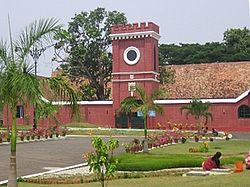- Nair Brigade
-
 Headquarters of the Nair Brigade of Travancore. The building is now the Legislative Museum of Kerala
Headquarters of the Nair Brigade of Travancore. The building is now the Legislative Museum of Kerala
The Nair Brigade was the army of the erstwhile kingdom of Travancore in India. Nairs were a warrior community in the region which was responsible for the security of Travancore and other local kingdoms. King Marthanda Varma's (1706–1758) personal bodyguard was called 'Thiruvithamkoor Nair Pattalam' (Travancore Nair Army). The Travancore army was officially referred as the Travancore Nair Brigade in 1818. In the early days, only Nairs were admitted into this brigade. Later, the unit was expanded and several sub units were formed. The name Nair Brigade remained unchanged, even following the admittance of non-Nairs. The army was involved in many services during peace time. The Headquarters of the brigade was in Thiruvananthapuram (Trivandrum).
Contents
History
The army of Travancore was modernised by Marthanda Varma, who is known as "the maker of modern Travancore". He defeated the Dutch Army with the Nair Brigade in 1741 at the Battle of Colachel and captured the Dutch commander Captain Eustachius De Lannoy.[1] Marthanda Varma agreed to spare the Dutch captain's life on condition that he joined his army and trained his soldiers on modern lines.[2] Marthanda Varma continued his expansion with this army and annexed all the princely states right up to Kochi in 1746. The Nair Brigade succeeded in defending against the invading army of Tipu Sultan of Mysore in A.D. 1791 near the Nedumkotta. Tippu Sultan had lost his sword in a war with the Nairs of Travancore. The Nair army under the leadership of Raja Kesavadas defeated the Mysore army near Aluva. The Maharaja, Dharma Raja, gifted the famous sword to the Nawab of Arcot, from where the sword went to London. The sword was on display at the Wallace Collection, No. 1 Manchester Square, London.[citation needed]
The Travancore army was reorganised as the Travancore Nair Brigade in 1818.[3] The Travancore Army was considered a part of the Indian State Forces from 1935. The units were known as the First, Second and Third Travancore infantry. The State Forces consisted of infantry units, the State Forces Artillery, the Travancore Training Centre, the Sudarsan Guards and the State Forces Band.[4] With the integration of the State into the Indian Union, the Nair Brigade was integrated into the Indian Army as the 9th Battalion Madras Regiment(1st travancore) and the 16th Battalion of the Madras Regiment(2nd travancore) in 1954.
Other Interesting Facts
- The area where the Travancore Brigade was settled came to be called Palayam, which means army settlement. The area is still called so, even though it has changed to a market.
- The Muslim Cavalry soldiers of the Nair Brigade of Travancore, who had settled in Sasthamangalam and Vattiyoorkavu, built an impressive mosque in Vattiyoorkavu.[5]
- The famous Pazhavangadi Ganapathi Temple in Thiruvananthapuram was owned and maintained by the Travancore Brigade. This temple is now owned and maintained by the Indian Army, after the integration of Travancore Army with the Indian Forces.
- The first group of State Forces of Cochin Kingdom was also called as the Nair Brigade in 1940. The Brigade's name was changed in 1945 to Cochin State Forces by Kerala Varma and allowed non-Nairs also to be admitted into his army.
Strength
The Nair Army of Travancore was very strong during 1700s and 1800s. They defeated Dutch Army in Battle of Colechal and was the strong force in the region. Later, with the strengthening of English East India Company, and with Travancore signing the treaty with British government for handing over the defence to British Army, Nair Brigade count was reduced. British Army was responsible for the country defense since this treaty.
The total strength of Travancore Nair Army as of 1945 was 4,082 men, of which 84 were officers and 132 were JCOs. A part of this force (those within medical categorization 'A') were absorbed in to the Indian Army (Travancore - Cochin unified forces), while the remaining forces were disbanded. After the unification of Travancore and Cochin forces, Trivandrum was declared as the headquarters of the unified command. Major General V.N. Parameswaran Pillai, the GOC of the Travancore Nair army became the commandant of the unified forces. The unified force was divided in to five infantry battalions (Travancore - I, II, III and IV, Cochin I). The unification took place under Major General V.N. Parameswaran Pillai of Travancore and Lt Col G.S. Subbiah of Cochin on 20 May 1949. Finally the forces unified Travancore-Cochin forces were either disbanded or absorbed in to the Indian Army and Major General V.N. Parameswaran Pillai was allowed to retire.[6]
See also
- History of Thiruvananthapuram
- Battle of Colachel
- 9th Battalion Madrass regiment
Notes
- ^ "9 Madras : A Tale of ‘Terrors’". Sainik Samachar. The journal of India's Armed Forces. http://mod.nic.in/samachar/april15-04/body.html#l1. Retrieved 2007-04-20.
- ^ "Battle of Colachal". Sainik Samachar. The journal of India's Armed Forces. http://mod.nic.in/samachar/april15-04/body.html#l1. Retrieved 2007-04-20.
- ^ "Army of Travancore". REPORT OF THE ADMINISTRATIVE REFORMS COMMITTEE 1958. Government of Kerala. http://www.localgovkerala.net/lsgd-links/Committee/1Adminrpt1958.asp?intId=1. Retrieved 2007-02-19.
- ^ "Army Units of Travancore". REPORT OF THE ADMINISTRATIVE REFORMS COMMITTEE 1958. Government of Kerala. http://www.localgovkerala.net/lsgd-links/Committee/1Adminrpt1958.asp?intId=1. Retrieved 2007-02-19.
- ^ "Vattiyoorkavu chronicle". About Vattiyoorkavu (The Hindu). 2004-09-27. http://www.hinduonnet.com/thehindu/mp/2004/09/27/stories/2004092702380300.htm. Retrieved 2007-02-19.
- ^ S. N. Sadasivan (2005). Political and administrative integration of princely states. Mittal Publications. pp. 76–. ISBN 9788170999683. http://books.google.com/books?id=kWptYbzpXE8C&pg=PA76. Retrieved 7 June 2011.
External links
Categories:- Kingdom of Travancore
- Military history of India
- Culture of Kerala
- Military history of the Indian Princely States
- History of Thiruvananthapuram
- Nair
- History of Kerala
Wikimedia Foundation. 2010.
